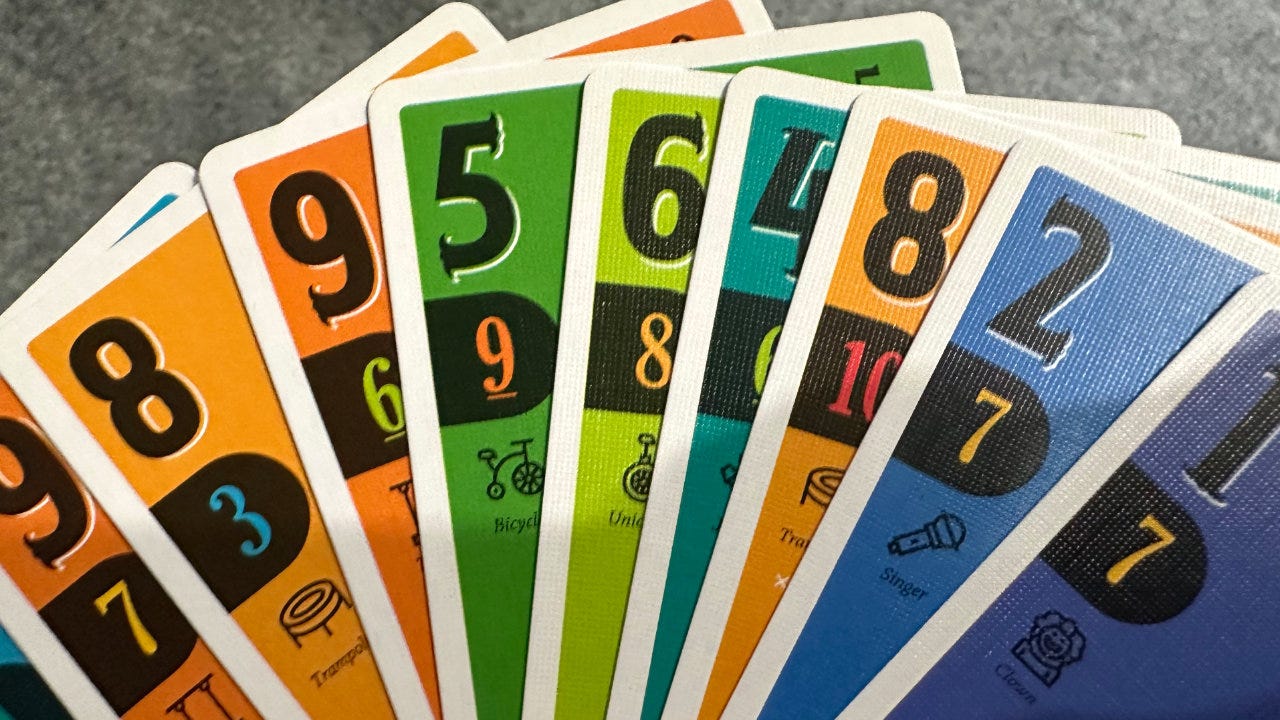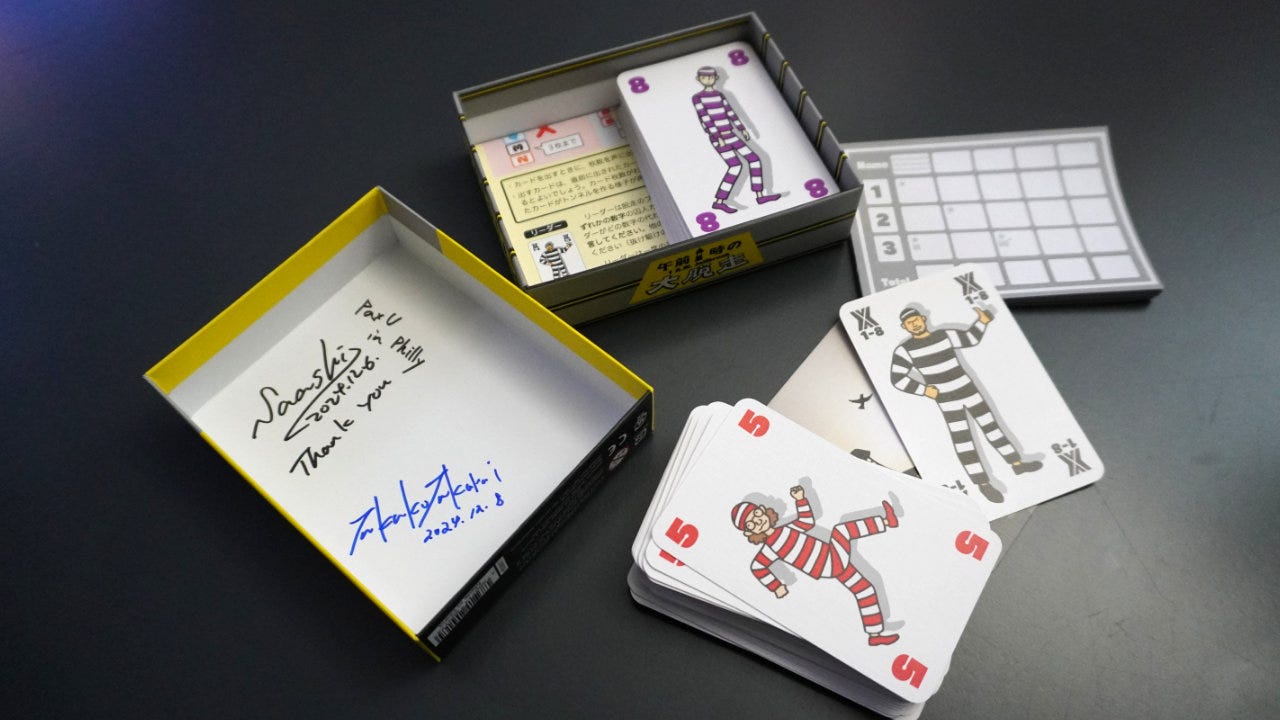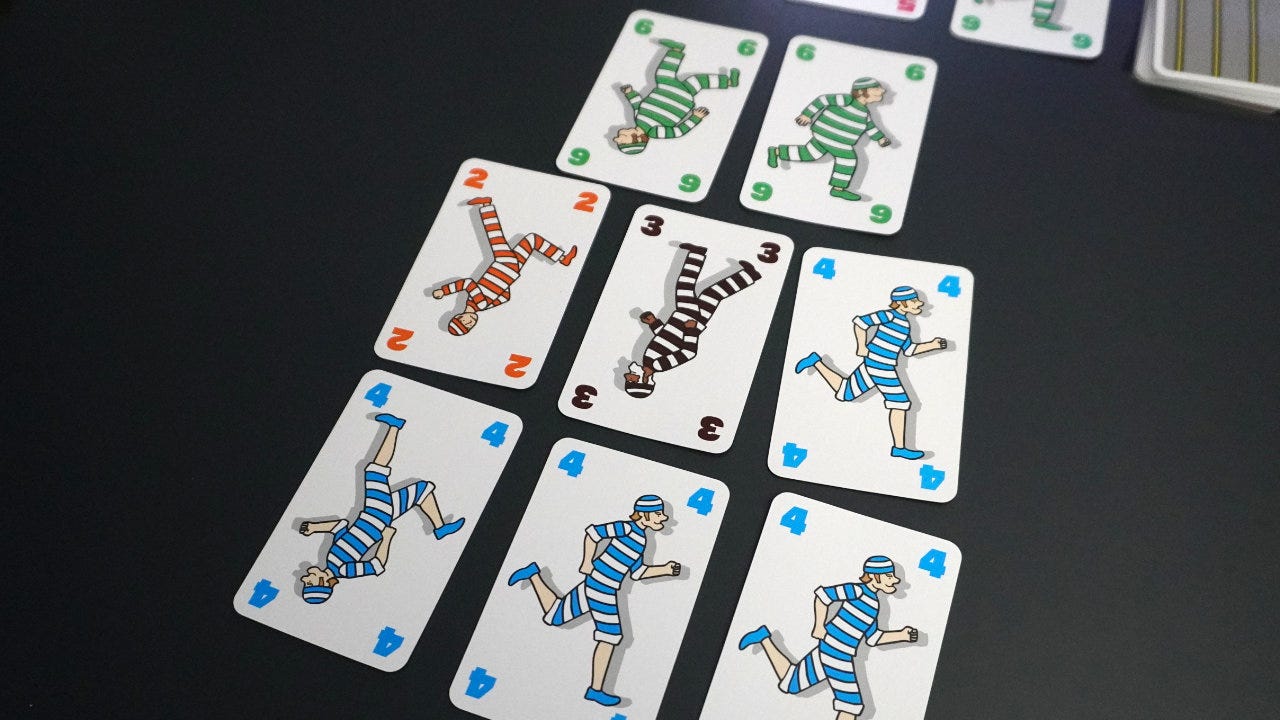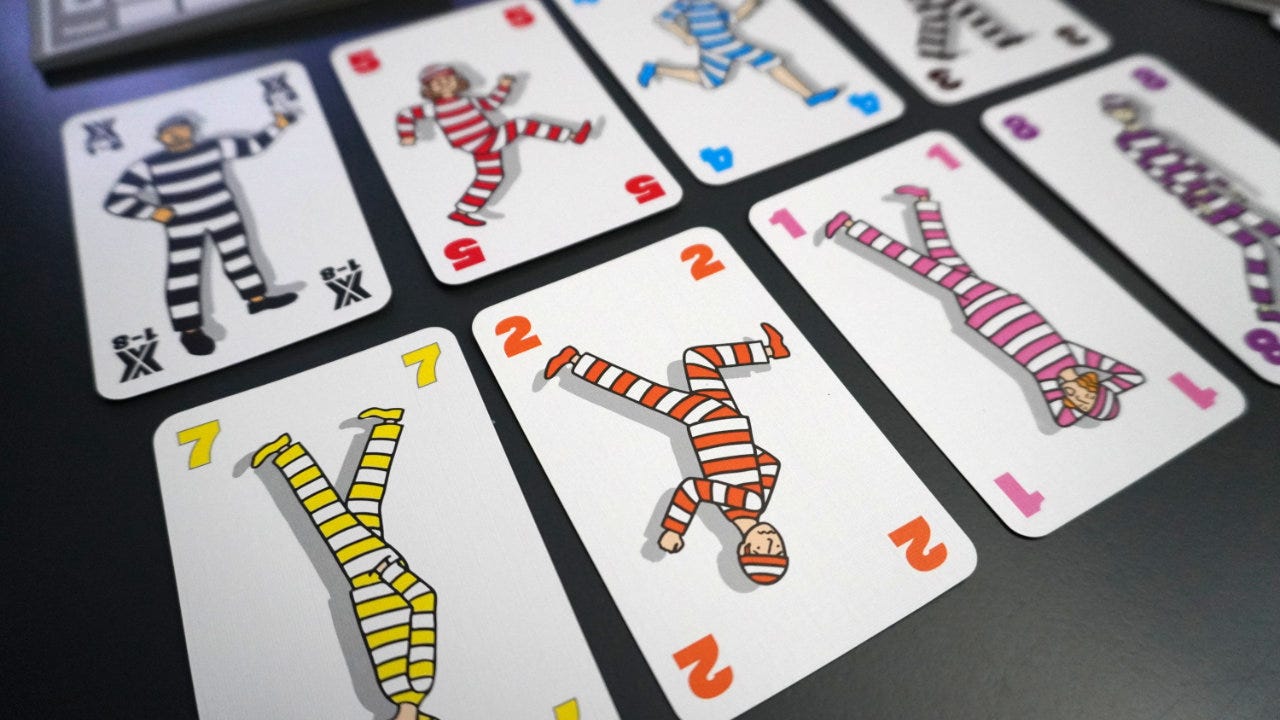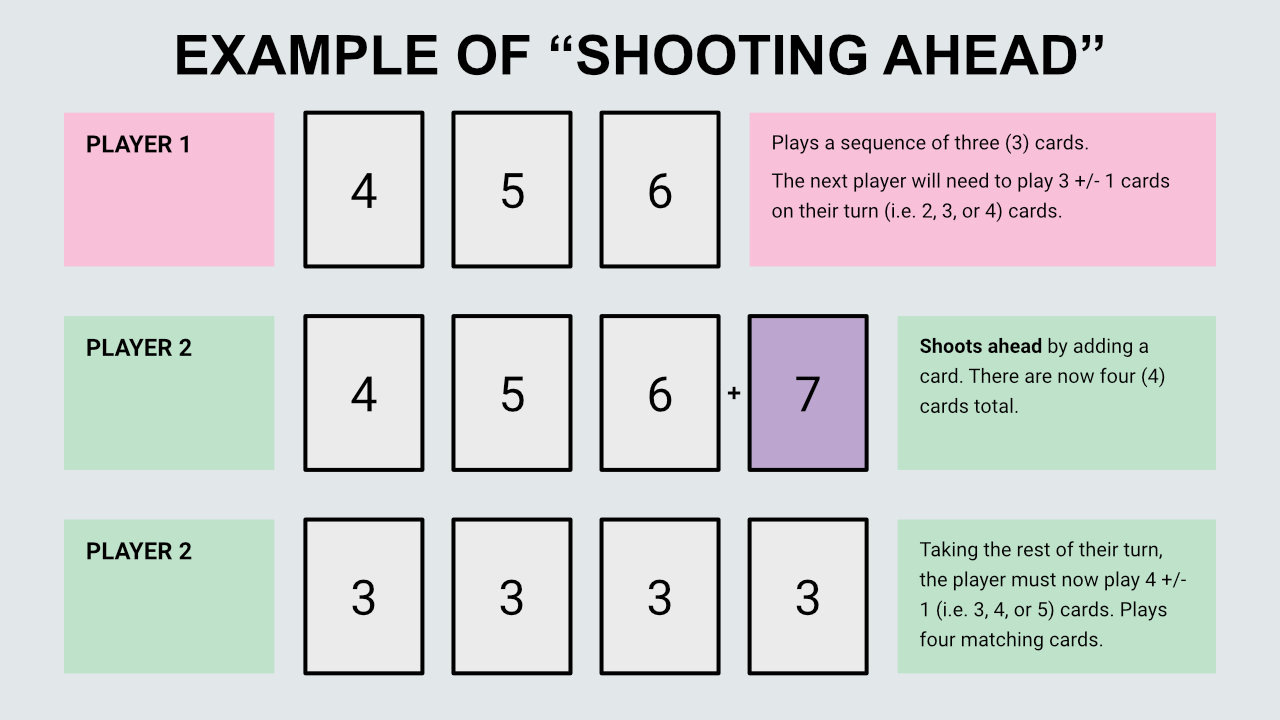Escape prison by shedding cards
Exploring card shedding games with Saashi & Saashi's 1 A.M. Jailbreak
Welcome to Skeleton Code Machine, an ENNIE-nominated and award-winning weekly publication that explores tabletop game mechanisms. Check out Public Domain Art and Fragile Games to get started. Subscribe to TUMULUS to get more design inspiration delivered to your door each quarter!
Last time we looked at hobbits, farmer birds, and area control games. There’s also the Skeleton Code Machine Gift Guide for those of you who are last-minute shoppers.
This week we are exploring a game I just picked up at PAX Unplugged: 1 A.M. Jailbreak.1
Card shedding games
Many tabletop games rely on accumulation of things to achieve victory. You take actions during the game to gather points, cards, tokens, or resources. Even simple card games like War work this way — the winner is the player who collects all the cards and leaves the other player(s) empty-handed.
Card shedding games flip this idea on it’s head.2 The goal is to discard (or otherwise get rid of) all of your cards before the other players.
The simplest example is Crazy Eights:
Setup: Deal five cards to all players, and place the deck face down on the table. One “starter” card is turned face up from the deck.
Play: Players must play a card to the starter pile, but the card must match the pile’s suit or value. Eights are wild and always match. If they can’t play a card, they draw cards to their hand until they can.
Victory: The first player to get rid of all cards from their hand wins.
The commercial variant of this game is, of course, Uno (Robbins, 1971).3 It adds actions cards such as Draw Two, Skip, and Reverse.
A famous, recent example of a card shedding game is Scout (Kajino, 2024) published by Oink Games. In addition to being a ladder-climbing game, the goal is to play all of your cards to remove them from your hand. Players do this by playing either sets (same value) or consecutive orders (e.g. 2, 3, 4), but they can only do this if their cards are ranked higher than what is on the table.
Other notable card shedding games include Haggis (Ross, 2010) and Tichu (Hostettler, 1991).4
1 A.M. Jailbreak
I was able to pick up a copy of 1 A.M. Jailbreak (Saashi, 2024) at PAX Unplugged over the weekend. I was fortunate enough to also meet both Saashi (designer) and Takako Takarai (artist). They very kindly signed my copy!
It’s a simple, abstract game with the theme of helping prisoners escape from prison. You do this by playing delightfully illustrated prisoner cards from your hand to “send them through the tunnel” to the freedom outside.5 As a card shedding game, you want to get rid of all of your cards as quickly as possible.
Although the game is light (Weight: 1.00 / 5 on BGG) the rules can be a little tricky on the first play. This won’t be a full rules explanation, and instead I’ll cover just enough to get an idea of how it plays.
Sending prisoners through the tunnel
Here’s how it works:
Deal each player 12 random cards (numbered 1-8) and a leader wildcard.
Set up a market of 5 face up cards and a face down deck of the remaining cards, with the “daybreak” card at the bottom.
Players take turns playing 1 - 8 cards with the following restrictions:
Only play +/- 1 cards more or less than the previous number played. For example, if five cards are played then the next player can only play 4, 5, or 6 cards on their turn.
Cards must either all be of matching value (e.g. 5, 5, 5, 5) or a consecutive sequence of values (e.g. 4, 5, 6, 7).
If you can’t play any cards, you have to pass.
If you have played your last card, you are out for that round. Otherwise you’ll take 1 or 2 cards from the market and deck.
This continues until 1 or 2 players (depending on player count) have “broken out” (i.e. shed all of their cards). Any cards left in your hand are 1 penalty point each. Do that for three games and add up the penalties. Lowest score wins.
Shooting ahead
The one mechanism that was most interesting for me was the ability to “shoot ahead” at the start of a turn. To shoot ahead, you can add one card to the cards that were played before your turn. For example, if someone played a set of four fours (4/4/4/4) you could add one additional 4 to it (4/4/4/4/4). If someone had played a sequence of three cards (2/3/4) you can add one to either end (1/2/3/4 or 2/3/4/5).
This creates a really interesting choice! Shooting ahead allows you to shed one extra card on your turn, but it also changes the number of cards you are allowed to play on your turn. You must always play +/- 1 cards vs. the previous play, and shooting ahead changes that number. If there were four 4s and you add a 5th 4, you now must play 4, 5, or 6 cards (i.e. 5 +/- 1).
You might want to shoot ahead, but it will mean you then can’t play the right number of cards. This will force you to not shed as many cards, pass, and take two more cards.
Or you might shoot ahead so you can set yourself up to play a bigger combo of cards.
Shooting ahead is a key part of the game, and feels great when you can use it to play a large sequence of cards.
Ladder climbing with cards
I explored ladder climbing mechanisms with Scout. I’m not sure if what 1 A.M. Jailbreak is doing with cards is ladder climbing exactly, but it has that feel. The difference is that you can move both up and down the ladder.
You can ratchet up the number of cards that must be played, but can just as easily step it down to smaller numbers. It’s a constant back and forth rather than a single direction climb.
Conclusion
Some things to think about:
Know your mechanisms: Do you need to know what “ladder climbing” is to enjoy 1 A.M. Jailbreak? Of course not. I do think, however, that learning a better vocabulary for game mechanisms actually changes how you think about games. It allows you to quickly identify similar mechanisms, and spot how designers have made interesting changes and twists to them.
Abstract games are OK too: There is ostensibly a them in 1 A.M. Jailbreak, it’s essentially an abstract game with numbered cards. I prefer thematic games, but abstract ones can be fun too. While they will probably never be in my Top 10, I always learn something new.
Take a mechanism and change it: Ladder climbing games are well known, using suit or value to climb the ladder. It’s fun to see changes to this, allowing players to go both up and down the ladder.
— E.P. 💀
P.S. I’m back from PAX Unplugged! I’m so glad I was able to meet as many of you as I did, and sorry I wasn’t able to meet everyone that was there. Never enough time.
Skeleton Code Machine is a production of Exeunt Press. All previous posts are in the Archive on the web. Subscribe to TUMULUS to get more design inspiration. If you want to see what else is happening at Exeunt Press, check out the Exeunt Omnes newsletter.
John McLeod maintains a page about card shedding and accumulation games. He gives credit to game designer David Parlett for coining the term “shedding games” for this type of game. He also notes that some call these games “stops games” but I find that term both non-obvious and unpleasant to say/pronounce.
Haggis is notable because it works really well at two-players where my experience has been that games such as Scout work better at higher player counts.
Takako Takarai creates the art for all the Saashi & Saashi games and it’s just lovely. Check out the cover of Photograph (Saashi, 2016) for another example.


